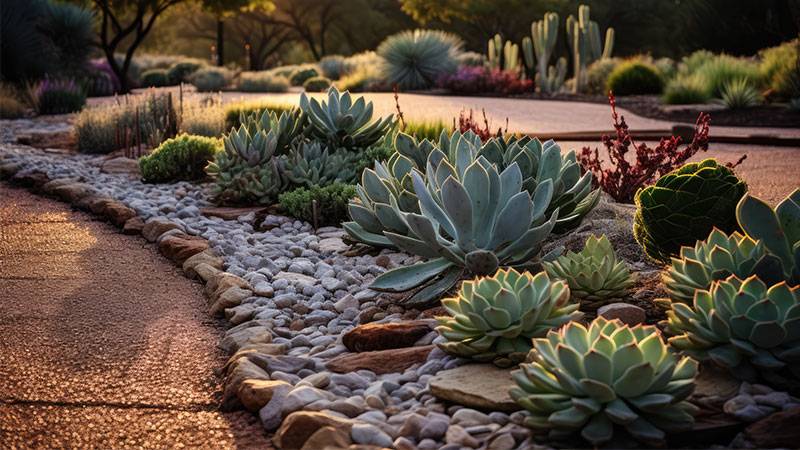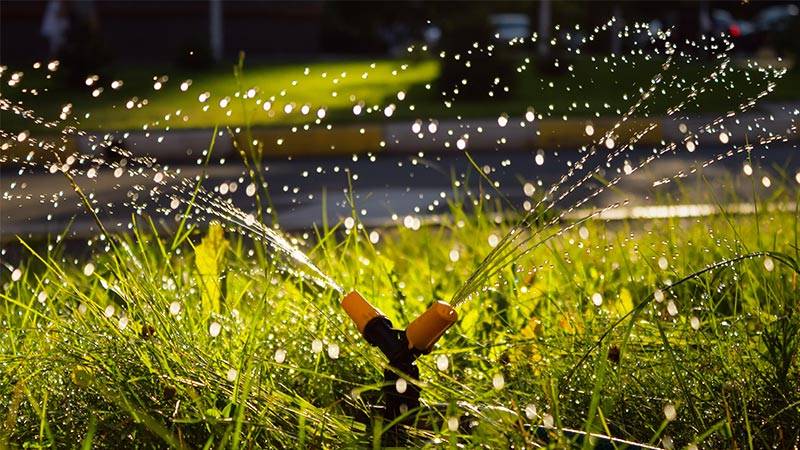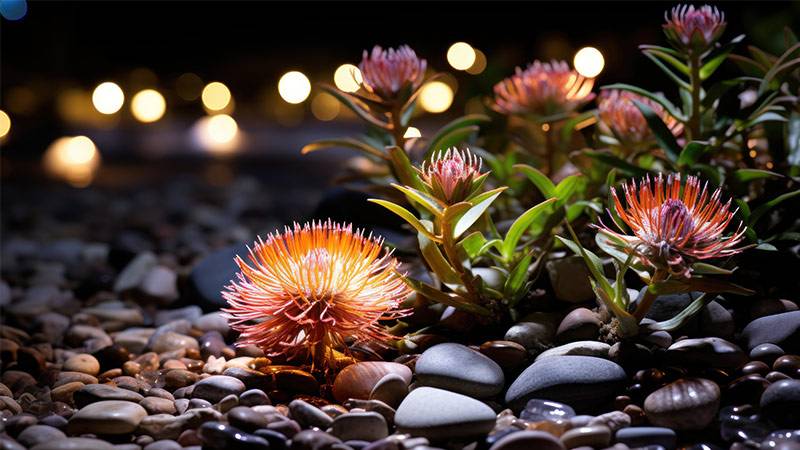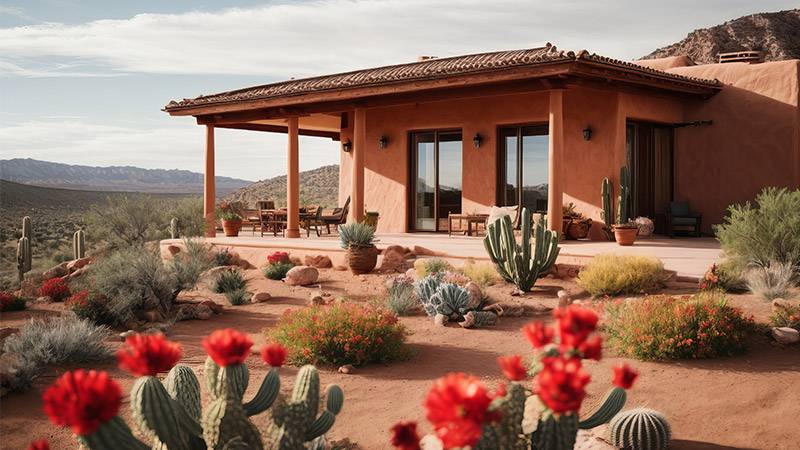I walked through my garden, and wow—it was like a whole new world! What used to be a dry, sad patch of dirt was now full of colorful, tough plants that didn’t need much water. It wasn’t just alive—it was thriving!
All this happened because I tried xeriscaping. No more endless watering or stressing about water rules. Instead, I’ve got a garden that saves water and still looks amazing.
Each plant, each rock has its own story about caring for nature and keeping things green. Let me show you how you can create your own water-smart garden, step by step!
What is Xeriscaping?

Xeriscaping is a landscaping method focused on water conservation, ideal for areas prone to drought or for anyone aiming to reduce their water usage and maintenance. The term originates from the Greek word “xeros,” meaning dry, and it involves designing gardens that thrive with minimal water.
This method isn’t just about selecting drought-resistant plants; it’s a comprehensive approach that includes planning and designing, soil analysis and improvement, efficient watering practices, and the use of mulches to retain soil moisture. The goal is to create an aesthetically pleasing landscape that’s also sustainable and eco-friendly.
While xeriscaping is especially beneficial in arid climates, its principles can be applied in any region to promote water conservation and create a low-maintenance garden.
As water scarcity becomes a more pressing global issue, xeriscaping is gaining relevance, offering a practical and environmentally responsible solution for gardeners and landscapers. It’s a smart way to reduce your environmental footprint while enjoying a beautiful, resilient garden.
Why Xeriscape?

Xeriscaping isn’t just a gardening trend; it’s a significant shift towards more sustainable and eco-conscious landscaping practices.
Globally, it addresses the pressing issue of water scarcity. By reducing dependency on irrigation, xeriscaping plays a crucial role in conserving water—a resource that’s becoming increasingly precious.
Locally, it helps homeowners and communities significantly cut down their water usage. For instance, studies have shown that a well-designed xeriscape can reduce outdoor water use by 50 to 75%.
But the benefits of xeriscaping extend beyond water conservation. By promoting the use of native plants, it supports local biodiversity, providing habitats for native wildlife like birds, bees, and butterflies.
This alignment with the local ecosystem also means fewer chemical inputs like fertilizers and pesticides, leading to healthier soil and less groundwater contamination.
Furthermore, xeriscaping can contribute to climate-resilient gardening. Plants adapted to local conditions are more likely to withstand extreme weather, from droughts to heavy rains.
This not only ensures the survival and beauty of your garden but also reduces the need for resource-intensive maintenance and replacements.
In essence, xeriscaping is a holistic approach to landscaping that nurtures the land, conserves vital resources, and fosters biodiversity, making it a wise choice for both the earth and the gardener.

Read More:
Benefits of Xeriscaping
Xeriscaping brings a plethora of benefits, making it an appealing option for gardeners and homeowners alike. Here are some key advantages:
Reduced Water Usage
Xeriscaping can significantly lower your garden’s water requirements. Traditional landscapes may consume vast amounts of water, but xeriscaped gardens are designed to thrive with minimal irrigation.
This not only conserves a precious resource but also translates to lower water bills.
For instance, converting a standard lawn into a xeriscape can reduce water use by 50-75%, offering substantial savings especially in drought-prone areas.

Lower Maintenance
Once established, xeriscaped gardens typically require less upkeep. They don’t need frequent watering, mowing, or fertilizing like traditional lawns.
This means less time and money spent on maintenance and more time to enjoy your outdoor space.
The use of perennial plants and durable ground cover alternatives in xeriscaping can significantly reduce the need for seasonal planting and soil tilling.
Cost-Effectiveness
While there might be initial costs in setting up a xeriscape, the long-term savings are substantial.
Reduced water usage, minimal need for chemical treatments, and less frequent replacements of plants contribute to ongoing financial savings.
Over time, the investment in xeriscaping can pay for itself through reduced utility bills and lower maintenance costs.

Increased Property Value
A well-designed xeriscape can enhance curb appeal and potentially increase your property’s market value.
It’s an investment that pays off not just in savings and sustainability but also in aesthetics and property valuation.
Eco-conscious buyers are often drawn to properties with sustainable features, making xeriscaped yards a desirable asset.
Positive Environmental Impact
Xeriscaping goes hand in hand with eco-friendly gardening practices. It promotes soil health, reduces chemical runoff, and supports local wildlife by incorporating native plants.
By mimicking natural ecosystems, xeriscaped gardens contribute to biodiversity and help create more sustainable communities.
Additionally, by reducing the need for lawn mowers and other gas-powered equipment, xeriscaping also contributes to lower carbon emissions.

Read More:
The 7 Principles of Xeriscaping

Xeriscaping is both an art and a science, governed by seven core principles that ensure its success and sustainability. Here’s how you can incorporate these principles into your own garden:
1. Thoughtful Planning and Design
Before you begin, carefully plan your xeriscape. Assess your yard’s soil, light, and existing vegetation. Design your landscape to minimize water use and maintenance. Consider factors like water runoff, the placement of drought-tolerant plants, and how you’ll incorporate different zones in your garden.
2. Soil Improvement
Healthy soil is the foundation of a successful xeriscape. Enhance your soil’s structure and nutrient content to support your plants better. Adding organic matter can improve water retention and aeration, making your garden more drought-tolerant and resilient.
3. Efficient Irrigation
Even low-water landscapes need some moisture. Design an irrigation system that meets your garden’s needs without waste. Drip irrigation systems and soaker hoses are great choices for xeriscaping, delivering water directly to the plant roots where it’s needed most.
4. Appropriate Plant Selection
Choose plants that are well-adapted to your local climate and soil conditions. Native plants and drought-tolerant species are the cornerstones of xeriscaping. They require less water and maintenance and offer habitat for local wildlife.
5. Practical Turf Areas
Limit the size of your lawn, as grass typically requires a lot of water. Consider alternatives like ground covers or artificial turf for areas where you want green without the high water use.
6. Use of Mulch
Mulch is essential in xeriscaping. It conserves soil moisture, reduces weed growth, and adds an aesthetic finish to your garden. Organic mulches like bark or compost also improve soil quality as they decompose.
7. Regular Maintenance
While xeriscaped gardens require less upkeep, some maintenance is necessary. Regularly check your irrigation system, prune your plants to promote health and growth, and replace mulch as needed. Proper care will keep your xeriscape looking beautiful and functioning efficiently.
Best Plants for Xeriscaping
Xeriscaping thrives with plants that are as beautiful as they are resilient. Here’s a curated selection of plants that will bring life and color to your water-wise garden, categorized for easy reference:
Succulents
- Agave
- Aloe Vera
- Sedum (Stonecrop)
- Sempervivum (Hens and Chicks)
- Echeveria
- Yucca
- Opuntia (Prickly Pear)
- Haworthia
- Crassula (Jade Plant)
- Kalanchoe
Grasses
- Buffalo Grass
- Blue Fescue
- Bermuda Grass
- Zoysia Grass
- Blue Grama Grass
- Fescue (Tall and Fine varieties)
- Switchgrass
- Indian Grass
- Little Bluestem
- Maiden Grass (Miscanthus)
Shrubs
- Lavender
- Sage (Salvia)
- Butterfly Bush (Buddleia)
- Russian Sage
- Texas Ranger (Leucophyllum)
- Rockrose (Cistus)
- Juniper
- Manzanita
- Creosote Bush
- Ceanothus (California Lilac)
Perennials
- Coneflower (Echinacea)
- Yarrow (Achillea)
- Black-eyed Susan (Rudbeckia)
- Coreopsis
- Sedum (Stonecrop)
- Catmint (Nepeta)
- Perennial Salvia
- Lamb’s Ears (Stachys)
- Russian Sage (Perovskia)
- Daylily (Hemerocallis)
Additional Tips for Xeriscape Landscaping

Embracing xeriscaping is not just about creating an eco-friendly garden; it’s about sustaining its beauty and functionality with the right practices. Here are some actionable tips for maintaining your xeriscape garden effectively:
Prioritize Efficient Watering
Even drought-tolerant plants need water to establish their roots. Use water-efficient irrigation methods like drip irrigation or soaker hoses to deliver water directly to the roots, where it’s most needed.
Embrace Mulching
Mulch is your garden’s best friend. It conserves moisture, regulates soil temperature, and helps control weeds. Organic mulches like wood chips or straw also add nutrients to the soil as they decompose.
Weed Regularly
Weeds can be particularly aggressive in competing for water and nutrients. Regular weeding ensures that your plants aren’t fighting for what they need to thrive.
Prune Strategically
Pruning isn’t just about keeping your garden tidy; it’s about encouraging healthy growth and flowering. Remove dead or diseased branches to help your plants focus their energy on producing vibrant blooms and foliage.
Monitor and Adapt
Be observant of how your plants respond to the environment and care practices. Xeriscaping is about adaptation. If a plant isn’t thriving where it’s planted, consider moving it to a different spot or replacing it with a more suitable species.
Learn from Challenges
Every garden faces challenges, from pests to unexpected weather. View these as opportunities to learn and adapt your practices. For instance, if certain plants aren’t thriving, research and transition to more native or drought-resistant varieties.
Conclusion
Xeriscaping is a practical, environmentally friendly approach to landscaping that conserves water and supports local ecosystems.
By choosing the right plants, utilizing efficient watering techniques, and maintaining your garden wisely, you can enjoy a beautiful, low-maintenance outdoor space.
Adopting xeriscaping isn’t just good for your garden; it’s a positive step towards a more sustainable lifestyle.
Consider making the switch to xeriscaping and contribute to water conservation in your own backyard. Ready to get started? Your sustainable garden journey begins now.


